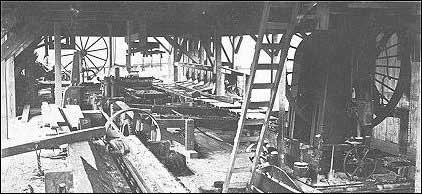The Manufacturing Plant
The saw mill could be either portable or permanent. A portable saw mill could be setup to saw a small tract of land, and when finished, moved to another “set” or location on the lumberman’s property; moved to an entirely different area or; sold to others. Many of the smaller logging railroads employed this method, or used a portable mill along its route to supplement the production of a larger mill located at the railhead.
A permanent mill was usually a mill constructed to manufacture lumber from large acreage, or numerous tracts of timberland. It was this style of saw mill which was most frequently associated with the logging railroad. Almost all mills were entirely of frame construction with the use of concrete or masonry limited to the construction of mill and machinery foundations. Frequently, the boiler house was also constructed of masonry. Very few mills were built of stone or metal.
The typical saw mill, served by a logging railroad, was housed in a wooden frame structure. They were built by either using lumber sawn at a portable saw mill moved onto the site or material hauled onto the site. The method used depended on available transportation. A wooden structure was more resilient, which caused less wear and tear on the machinery. It was less noisy, but was subject to rapid deterioration, especially if the lower frame members were damp most of the time. The latter problem could be remedied by the use of treated timbers; but their use was relatively unknown in the early years of the industry. The fire hazard was greater with a wooden building, but a wood framed building could be easily repaired from material on hand.
The foundation was of the utmost importance. Any settlement would throw the shafting within the building out of line and cause serious damage to the machinery. The early mill foundations were constructed of masonry by a competent stone mason, using material gathered from the surrounding area and, usually, there was an ample supply of raw material available. The use of concrete became more prevalent with the approach of 1900, and afterwards was used to a much greater extent.
Saw mills utilizing a circular head saw could be one story in height, but frequently they were two-story structures. This elevated the machinery and allowed it to be placed above the ground away from moisture. It also permitted the lumber to be stacked higher for drying. Lumber piles which were often 20 to 30 feet in height and raising the mill floor 10 to 15 feet, allowed these higher piles, especially where available land was limited. The size of any mill building depended upon the machinery installed in the building and the land available.

Interior View Of A Band Saw Mill
(Don Jones)
A mill with a band head saw was usually two stories in height and frequently incorporated an additional superstructure over the head saw to house the saw filing equipment. In addition, placing the superstructure in this location facilitated the raising and lowering of band saws between the mill floor and the filing room. A rope windlass usually performed the task attached to a simple elevator. The shafting, engines, log-turner, log-stop and steam-turner cylinders, refuse conveyors, and similar equipment were found on the ground floor and, most often, this floor was earth. The lumber manufacturing machinery, such as head saw, edgers, trimmers, slashers, transfers and other accessories were found on the second or mill floor. Usually, the only evidence remaining of such a mill after it was removed, was the concrete mill and engine foundations.
The most common reason for the destruction of a saw mill was fire; and in several locations a saw mill was destroyed and rebuilt several times. Some mills adapted the use of sheet iron on the exterior of the mill, but its use was infrequent. The majority of mill fires started internally, and the best fire prevention was to keep the mill clean and clear of rubbish, and to have an alert watchman. The most dangerous time for mill fires was at lunch time, or immediately after shutting down for the evening, because an overheating of bearings during the shift would ignite the surrounding material. Band mills were very dangerous during thunderstorms and, quite frequently, they were shutdown during a severe electrical storm.
Exterior fire protection was supplied by the common, but simple method of placing water barrels on the mill roof, or by fire hoses supplied by pumps in the power house. Very few mill towns had water systems capable of fighting a major fire. The saw mill was a large investment for the lumberman, and its costs could be exceeded only by the expense of constructing his logging railroad.
